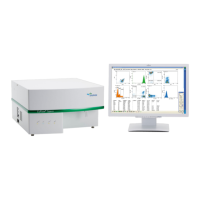CyFlow
™
Space | Operating Manual | March 2021
9
3 Typical Steps of Particle Analysis
3.1 Preparation and Staining
For flow cytometric analysis, the cells (or other particles) must be separated from each
other in an aqueous suspension. Typically, if not generating sufficient optical signals by
themselves, the cells are then labelled by staining with one or more fluorescent dyes. The
fluorescent molecules bind to the cell substance of interest, e.g. CD4- and CD45-antibodies
bind cell surface antigens of leukocytes. The quantity of labelling cells with a specific dye is
proportional to the number of antigen molecules of a single cell. A good preparation with
suited reagents is the requirement for a precise analysis. A check of staining in a
fluorescence microscope can un-reveal preparation problems.
Figure 1: Cells are separated in a suspension and stained with fluorescent markers
3.2 Flow Cytometry Analysis
While passing through a flow cuvette one-by-one, the cells are individually illuminated by
the light spot of the laser. Due to the excitation, the dye molecules emit fluorescence of
characteristic colour (emission wavelength spectrum). This fluorescence light is separated
into colour ranges by means of optical filters. The intensity of each colour range is analysed
for each single cell.
Besides fluorescence, the intensity of light scattered by each cell can be measured. Scatter
light is measured in forward direction from the light source (forward scatter, FSC) and
sideward direction (side scatter, SSC). The scatter intensity is a measure of cell size and
morphology. Scatter light can be used to identify a cell before analysing its fluorescence,
but a cell can also be identified by fluorescence before analysing its scatter properties.
Figure 2: Light from the laser(s) excites cell-bound fluorophores and is scatted by the cells
3.3 Real-time Data Processing and Results
The light intensity of each parameter, and with it the quantity of substance of interest, is
assigned to one of up to 216 or 65536 quantity classes (channels). The classification is
performed in real-time, while the cells are passing the flow cuvette. Single parameter

